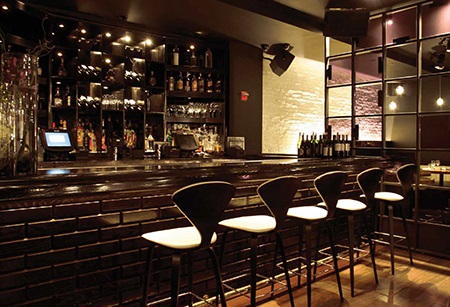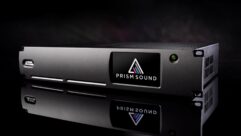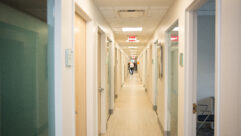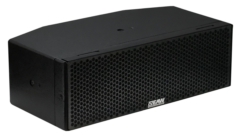

Walk into any one of the 10 (and growing) STK steakhouses around the world, and you’ll quickly understand why the chain’s motto is, “Not Your Daddy’s Steakhouse.” The ambience is more club than restaurant, with the thrum of DJ-spun dance tunes replacing the typical subdued background music of most highend eateries. The low-lit rooms are cavernous, with carefully crafted architectural details and ultra-mod, sleek furniture, creating an elegant, Rat-Pack-in-Las-Vegas vibe. Around 10 p.m., the DJ kicks things up even further, and the restaurant turns into an all-out nightclub, inspiring guests to get up from their seats to mingle and dance.
“It’s a full-blown party every night, and it runs to the wee hours of the morning,” says Karl Kieslich, national system design specialist, Sound Stage Systems, a sound, video and lighting systems integrator that has contracted with STK to perform upgrades or full installations of the sound and lighting systems at the chain’s locations across the U.S. and Europe. As he describes it, the concept of background music simply doesn’t exist at STK venues. Music is very much in the foreground. “The sound is integral to the atmosphere, just as important as the steak or the drinks that come out. It’s very deep, rich, and warm, and envelops the entire space. It creates a specific mood that makes you want to be part of the action.”
Keeping this in mind, Sound Stage Systems recently retrofitted a new sound system for one of STK’s New York locations, in the Meatpacking District. Comprising a main dining room, bar, lounge, and bistro-style space on the ground floor, four private dining rooms for parties and corporate events on the second floor, and a larger private dining room on the third floor, the venue is the original flagship steakhouse in the STK chain. Despite its nightlife-friendly air, STK wanted to maintain the space’s classy restaurant look, so placing large speakers and most other audio gear in view of patrons was out of the question.
“It wasn’t like the dance floor of a club, where you can fly speakers from the four corners and just hit the area with high SPL,” Kieslich says. “You couldn’t have big stacks of boxes on the floor and hanging from the ceiling. The architectural concept doesn’t allow that, so we had to have something with a small enough enclosure that we could hide into the architecture of the room.”

STK wanted to maintain the space’s classy restaurant look, so placing large speakers and most other audio gear in view of patrons was out of the question.
STK still wanted club-level sound, however. Drawing on their previous experiences installing sound systems for the restaurant’s other locations, Kieslich and his team decided the best audio setup should include several small speakers capable of high-SPL output. The speakers would be strategically placed throughout the STK space for maximum coverage but minimum visibility.
The first step was to locate such speakers, which Sound Stage Systems found in FBT’s Archon 208S passive sound-reinforcement subwoofer. At just 2”x8”, the speaker pumps out 132dB maximum SPL. The 12 speakers Kieslich and his colleagues chose for the site were just the right size to hide inside the restaurant’s banquette seating, invisible to guests. Complementing the FBTs were 18 low-profile RCFs Acustica C3110 two-way passive speakers (now discontinued), eight Control 26C and four Control 19CS ceiling speakers from JBL, and 14 JBL Control 28 foreground/background speakers. All low-profile, the SPLs for these speakers ranged from 127dB to 92dB peak. In addition to stashing them under the banquette seating, Sound Stage Systems hid the speakers around the ceiling area and tucked them up into various corners through-out the three levels of the STK Meatpacking location, out of sight of customers.
Other main components of the sound system were six XTi 6002, seven XTi 4002, and five XTi 20002 power amplifiers from Crown, two Pioneer CDJ-2000 multi-players, and a Pioneer DJM-2000NXS 4-channel digital mixer, for the DJ. In other STK locations, Sound Stage Systems generally implements Electro-Voice, FBT, or JBL speakers. STK has been so pleased with the performance of the FBT speakers in its venues especially that it has designed them into its blueprints for all future locations.

Once Sound Stage Systems placed the speakers in hidden locations, the next step was to get them to create the specific sonic ambiance STK cultivates.
Once Sound Stage Systems placed the speakers in hidden locations that also offered the best coverage spots, the next step was to get them to create the specific sonic ambiance STK cultivates. While the music is always pumping, earlier in the evening, when people are eating, STK keeps the volume down. Later, a DJ can dial up the music to dance-club levels. Still, it must retain the same high fidelity and rich warmth that is so integral to the STK vibe, regardless of the volume. As Kieslich describes it, the difference is similar to what one hears when hitting the loudness button on a home stereo system.
The sound must also be even throughout the entire STK space, even if the volumes are slightly different in individual zones. “The owner wanted different volumes in each area, but they still had to align with each other,” says Kieslich about STK’s Meatpacking location. “The music is usually louder in the bistro, for example, where people dance. In the dining area, after a while, they kick up the sound there as well. Walking through all the zones, you might hear different levels, but it should be seamless. You want to hear equal energy, all of the music, wherever you are, so that, from wherever you are sitting, it sounds like you’re in the best seat in the house.”
Controlling the levels of 24 different speakers is no small feat, which is why Kieslich and his team devised a processing scheme that would allow the speakers to act essentially as one large speaker. Although he says the scheme’s specifics are proprietary to Sound Stage Systems, he says that much of it involved a precisely detailed, thorough sound calibration of the site—something the company performs for all projects. “We spent about two days analyzing the space,” he says. “Once all of the speakers were in, and everything was wired, we turned the system on and ran either pink or white noise through it and took 100 different readings with specialty microphones, things like how fast a certain speaker was traveling to a specific location, if it was reflecting off a certain wall, if was decaying at a certain point.”

You want to hear equal energy, all of the music, wherever you are, so that, from wherever you are sitting, it sounds like you’re in the best seat in the house.”
Once they gathered all the information they needed, Kieslich and company used Rational Acoustics’ Smaart sound-system analysis software to pinpoint trouble spots and to determine the specifics of aligning and processing the system. “We did it for each speaker,” says Kieslich. “We checked things like, ‘Okay, that speakers needs to be delayed a few milliseconds, or needs a filter for this frequency.’”
For STK’s Meatpacking restaurant, Sound Stage Systems implemented a DSP system using one BSS Soundweb London BLU-160 signal processor, controlling eight zones—including the dining area, bistro, lounge, and bar, along with the private dining rooms. As with most STK restaurants, the Meatpacking venue has three input sources, including one for the DJ’s mixer, one for a computer running the song list, and a remote hookup for additional devices, such as an iPod. As for outputs, each speaker has its own DSP channel. To accommodate the large number of speaker outputs, Sound Stage Systems also worked with two BSS BLU-BOB (breakout box) output expanders.
Sound Stage System works almost exclusively with the BSS Soundweb London BLU-160 processor due to its open platform, which Kieslich says makes it much easier to configure a specific processing scheme. “It’s very customizable,” he says. “It’s almost endless what you can do with it. Also, for [STK’s Meatpacking location], we needed one DSP channel for each speaker, so we could process that speaker as we needed from our readings, so we liked that it offers the option, with the breakout boxes, for a lot of outputs.”
Sound Stage Systems also handled the installation of video for the private dining rooms. Each room now features a 60-in. LED display from LG. Every display has a satellite TV input and a local input for a laptop for presentations, with the feeds going through a video distribution system.

The STK Meatpacking installation took Sound Stage Systems less than a week to complete, although the process wasn’t without its logistical challenges. As this was a retrofit into an existing, operating restaurant, Kieslich and his crew couldn’t leave a specific area of the venue appearing as though it were under construction when they left each day. They also had to complete any major visible renovations of each spot by 5 p.m., in anticipation of the restaurant’s opening for business for the evening. Additionally, the venue was hosting a major function on Friday evening the week of the installation, which gave Sound Stage Systems a week to complete the job.
Sound Stage Systems finished the majority of the work by Thursday, giving them some extra time to perform further calibration and refinement. As with their work on previous STK venues, STK executives were pleased with the job they did on the sound system. As of this writing, the company is currently undertaking installations at STK restaurants in Chicago, Dallas, Denver, and Orlando.










